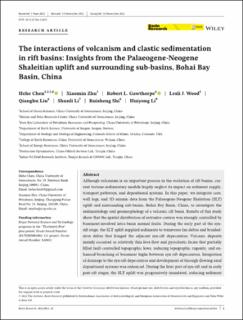| dc.description.abstract | Although volcanism is an important process in the evolution of rift basins, current tectono-sedimentary models largely neglect its impact on sediment supply, transport pathways, and depositional systems. In this paper, we integrate core, well logs, and 3D seismic data from the Palaeogene-Neogene Shaleitian (SLT) uplift and surrounding sub-basins, Bohai Bay Basin, China, to investigate the sedimentology and geomorphology of a volcanic rift basin. Results of this study show that the spatial distribution of extrusive centres was strongly controlled by basement-involved intra-basin normal faults. During the early part of the syn-rift stage, the SLT uplift supplied sediments to transverse fan deltas and braided-river deltas that fringed the adjacent syn-rift depocentres. Volcanic deposits mainly occurred as relatively thin lava flow and pyroclastic facies that partially filled fault-controlled topographic lows, reducing topographic rugosity, and enhanced breaching of basement highs between syn-rift depocentres. Integration of drainage to the syn-rift depocentres and development of through-flowing axial depositional systems was enhanced. During the later part of syn-rift and in early post-rift stages, the SLT uplift was progressively inundated, reducing sediment supply to the fringing transverse depositional systems. In contrast, axial braided-river deltas became the main depositional systems, sourced by large hinterland drainage from the Yanshan fold-belt to the northwest. Volcanism in the late syn-rift and early post-rift occurs as thick lava flow and pyroclastic facies that infill rift topographic lows and locally blocked axial fluvial systems creating isolated lakes. Within hanging wall depocentres, volcanic topographic highs split and diverted axial fluvial and deltaic systems. Furthermore, volcanism supplied large volumes of volcanic sediment to the rift resulting in increased sedimentation rates, and the development of unstable subaerial and subaqueous slopes and deposits, increasing the occurrence of landslides. Based on the observations of this study we update tectono-sedimentary models for rift basins to include volcanism. | en_US |

